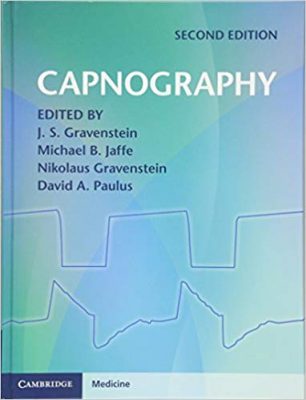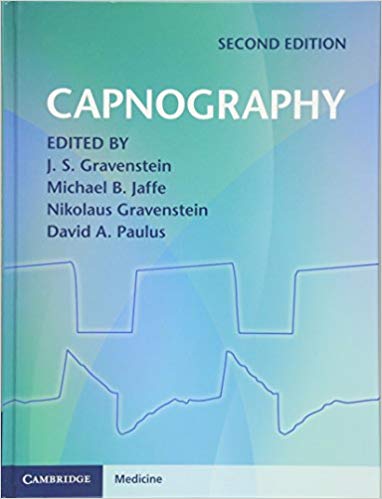 Editors: J.S. Gravenstein, MD; Michael B. Jaffe, PhD; Nikolaus Gravenstein, MD; and David A. Paulus, MD
Editors: J.S. Gravenstein, MD; Michael B. Jaffe, PhD; Nikolaus Gravenstein, MD; and David A. Paulus, MD
Publisher: Cambridge University Press – 474 pages
Book Review by: Nano Khilnani
Capnography is the monitoring of the concentration or partial pressure of carbon dioxide in respiratory gases. Its main development has been as a monitoring tool for use during anesthesia and intensive care. It is usually presented as a graph of expiratory CO2 (measured in millimeters of mercury, expressed as ‘mmHg’) plotted against time, or less commonly but more usefully, expired volume. The plot may also show the inspired CO2, which is of interest when re-breathing systems are being used.
The capnogram is a direct monitor of the inhaled and exhaled concentration or partial pressure of CO2, and an indirect monitor of the CO2 partial pressure in the arterial blood. In healthy individuals, the difference between arterial blood and expired gas CO2 partial pressures is very small. In the presence of most forms of lung disease and some forms of congenital heart disease (the cyanotic lesions) the difference between arterial blood and expired gas increases is quite high, and can exceed 1 kPa.
The editors state in the Preface that this book explores carbon dioxide physiology, monitoring, and its operative as well as its non-operative applications. They inform us that in some applications, capnography has already taken a foothold and has become the standard of care, while in other applications, it is emerging, as more clinicians become familiar with capnograms, their applicable uses, and he results they deliver.
This book provides you the reader, various capnographic images, with analyses of the findings, and by practicing to examine and correctly analyze them, you can become good in capnography.
The authors inform us of their findings in utilizing capnography and in that respect, its development has been chronicled in the chapters within the section on historical perspectives.
Sixty-seven specialists in various fields such as airway management, anesthesiology, bioengineering, biomedical engineering, bronchoscopy, critical care, electronics, emergency medicine, intensive care, medical sensors, pediatric critical care, pulmonary medicine, surgery, and veterinary clinical sciences, authored the 42 chapters of this book.
The chapter writers are from all over the United States and eight other countries – Argentina, England, Germany, Holland, Israel, Italy, Spain, and Switzerland.
Too numerous to list the titles of all 42 chapters, we name below the six Sections of this work in order to give you a broad perspective of its coverage
Clinical Perspectives
- Section I. Ventilation
- Section II. Circulation, Metabolism, and Organ Effects
- Section III. Special Environments and Populations
- Section IV. Physiological Perspectives
- Section V. Technical Perspectives
- Section VI. Historical Perspectives
To get a sort of bird’s eye view of the process of breathing and why it is essential to living beings, let us look at what is discussed in chapter 1 entitled Clinical Perspectives, authored by J.S. Gravenstein. He begins the chapter with an Introduction that explains the process of inhaling oxygen and exhaling carbon dioxide:
“Unless you are on cardiopulmonary bypass or in deep hypothermia, you must breathe, that is, you must ventilate your lungs to pick up oxygen and delivery carbon dioxide (CO2) from the lungs to the outside. The detection – breath after breath – of appropriate volumes of gas and carbon dioxide in the exhaled gas (it is no longer air!) proves, in one stroke, several important facts”:
- Carbon dioxide is being generated by metabolic processes during which the body utilizes oxygen
- Venous blood brings the carbon dioxide from the periphery to the heart
- The heart pumps the blood through the lungs
- Ventilation of the lungs – spontaneous, manual, or mechanical – conveys the carbon dioxide, and other gases to the outside. As long as no contrivance, such as a ventilator, is attached to the patient, the journey of the carbon dioxide ends here as far as we are concerned.
The author then goes on to say that subsequent chapters in this book will deal in detail with the production, transport, and analysis of carbon dioxide. In this first chapter, the author shows and examines different time- and volume-based capnograms and invites readers to analyze them with a clinical eye, and detect problems related to ventilation, which he describes as “by far the most common clinical application of capnograthy.” So a brief outline of the contents of this first chapter is as follows:
- Introduction
- The Normal Time-Based Capnogram
- Artifacts
- Mechanical Artifacts
- Clinical Artifacts
- Interpreting an Artifact-Free Time-Based Capnogram
- Cardiovascular Issues
- Pulmonary Issues
- The Normal Volume-Based Capnogram
- Summary
- References
Various charts of capnograms are presented, with detailed captions, then discussions of what is revealed in them follow. This is a pioneering work in the emerging field of capnography and its growing utility and importance as a medical technology relating to anesthesia, intensive and critical care, and various other medical specialties
Editors:
J.S. Gravenstein, MD was the founder and long-time faculty member (research professor emeritus) in the Department of Anesthesiology at University of Florida College of Medicine in Gainesville, Florida.
Michael B. Jaffe, PhD is a biomedical engineer working in advanced technology for Philips Respironics in Wallingford, Connecticut since 1994, and currently serves on international standards committees relating to respiratory gas monitoring.
Nikolaus Gravenstein, MD is Professor in the Department of Anesthesiology and Department of Neurosurgery at the University of Florida College of Medicine in Gainesville, Florida.
David A. Paulus, MD is Professor in the Department of Anesthesiology at University of Florida College of Medicine in Gainesville, Florida.







